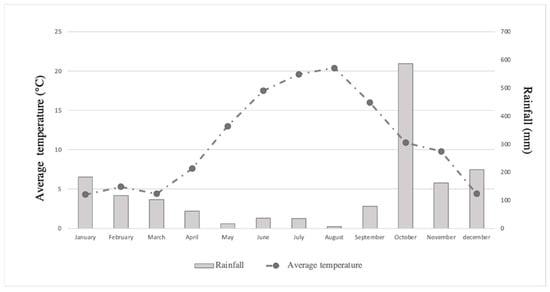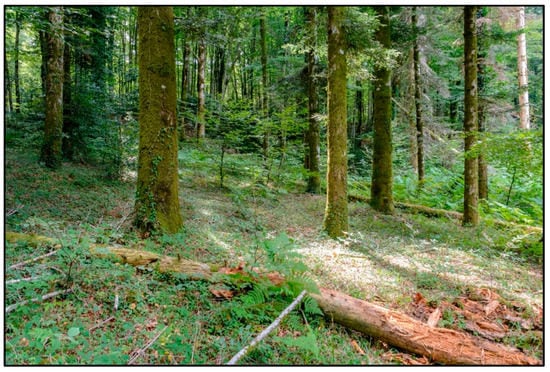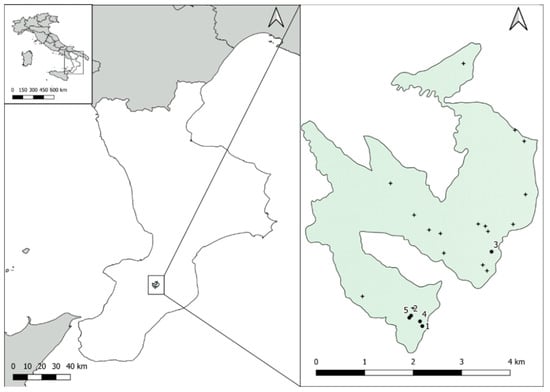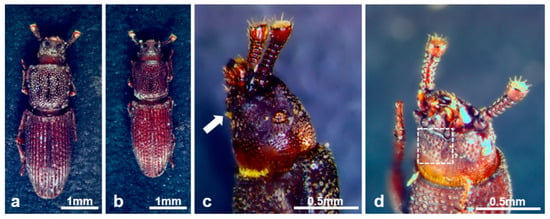Abstract
Pycnomerus italicus (Ganglbauer, 1899) (Coleoptera: Zopheridae), a saproxylic beetle endemic to Italy, is listed as “endangered” in the Red List of Italian Saproxylic Beetles. In 2021, during an entomological survey, 49 adults of this species were found in the Riserva Naturale Biogenetica Marchesale, Calabria, Southern Italy. The species was found in medium and high-quality habitats where a large number of fallen trunks of Abies alba Mill. 1759 (Pinales: Pinaceae) were present. On the same decaying trunks where P. italicus was found, larvae and/or adults of other three species of saproxylic beetles were detected. Although most aspects of the biology and ecology of P. italicus are still unknown, the presence of this endemic species in the Riserva Naturale Biogenetica Marchesale is interesting because this reserve and other humid forest environments in Southern Italy could be relevant refuges not only for this species but also for other endangered saproxylic beetles. These areas should be protected with appropriate forest-management techniques.
1. Introduction
Within the order Coleoptera, the superfamily Tenebrionoidea includes 28 families [1], including the family Zopheridae, divided into the subfamilies Colydiinae and Zopherinae [2]. The family Zopheridae has highly debated systematics [3]. Some members of the family are associated with dying trees of conifers or hardwoods and dead palm fronds [4,5], others are predators of bark beetles [6].
The tribe Pycnomerini, previously included within the former family Colydiidae [7], is presently considered as belonging to the family Zopheridae, subfamily Zopherinae [2]. Within the tribe Pycnomerini, the genus Pycnomerus Erichson 1842 includes 34 species, distributed all over the world [8]. In Europe, the genus Pycnomerus is represented by five species [9] and in Italy by three species, Pycnomerus terebrans (Olivier, 1790), Pycnomerus inexspectus (Jacquelin du Val, 1858), and Pycnomerus italicus (Ganglbauer, 1899) [9]. Pycnomerus inexspectus is probably an allochthonous species, which was accidentally introduced [10,11].
The species P. italicus, endemic to Italy, is listed as endangered (EN) in the Red List of Italian Saproxylic Beetles [11] because its habitat is declining due to forestry exploitation and structural changes in the tree populations [12].
The adults of the species were first described and reported as Dechomus sulcicollis (var. italicus m.) by Ganglbauer [13], based on specimens collected in Calabria (“calabrischen Stücken”). Later [14] referred to the same species as Dechomus italicus, citing Ganglbauer [13] and Porta [15] and mentioning its distribution as “Italien-Calabria”. In 1991, the presence of D. italicus was reported in Italy in three sites included in the territory of the Sila Plateau (Calabria, Southern Italy) [16]. In 1999, the genus Dechomus was considered a synonym of the genus Pycnomerus [2]. Consequently, D. italicus was reported as Pycnomerus italicus [9]. Recently, P. italicus was found in Basilicata in the Policoro wood, in Mount Vulture, and in the territory of Monticchio lakes, as well as in the Central Lucan Apennines, the Pollino Massif (Basilicata and Calabria), and the Aspromonte Massif (Calabria) [17]. This saproxylic species is associated with the dead wood of old-growth coniferous forests [12]. Although the adult morphology of P. italicus (syn. D. italicus) has been described [13,14,15], the larval morphology is unknown, and detailed knowledge about the biology, ecology, and population density of P. italicus is still unavailable [12]. Probably, like other saproxylic insects, P. italicus plays a relevant role in the degradation of wood and thus in the balance of forest ecosystems [18].
The Riserva Naturale Biogenetica Marchesale (Vibo Valentia, Calabria), enlisted under the code 0049 among the Italian protected areas (“Elenco Ufficiale delle Aree naturali Protette”, EUAP), was established in 1977 and is included in the European network of protected areas “Natura 2000” [19]. Presently, it is directed by the Raggruppamento Carabinieri Biodiversità.
Within a survey of the invertebrate community of the reserve, including endangered saproxylic beetles, a monitoring programme was carried out during 2021 in the municipalities of Arena and Acquaro, in the territory of the Riserva Naturale Biogenetica Marchesale. During this study, data on the presence and biology of P. italicus in the reserve were provided for the first time.
2. Materials and Methods
2.1. Sampling Area
The sampling area is located in the municipalities of Arena and Acquaro (Vibo Valentia) within the Riserva Naturale Biogenetica Marchesale, Calabria, Southern Italy. The reserve extends for about 1257.16 ha and its altitude reaches about 1200 m a.s.l. [19] The annual mean temperature recorded in 2021 was 11.1 ± 6.11 °C, and the total annual rainfall was 1594.4 mm (data from thermo-pluviometric station of Mongiana (Vibo Valentia) [20] (Figure 1).

Figure 1.
Total monthly rainfall and average monthly temperature recorded at Mongiana station (Vibo Valentia) in 2021 [20].
The substrate is composed of rocks of quartz-monzonites and granites, which produce acid soils [21]. The habitat of the reserve is mesic, and its forest vegetation includes arboreal species such as Fagus sylvatica L. 1753 (Fagales: Fagaceae), Abies alba Mill. 1759 (Pinales: Pinaceae), and Castanea sativa Mill. 1768 (Fagales: Fagaceae) [21]. At 800 m a.s.l., the artificial reforestation by C. sativa partially replaced the original Mediterranean mesophilous oak community [21]. Hygrophilous vegetation is well represented in the area of the reserve.
2.2. Insect Collection
Adults of P. italicus were hand-collected by entomological tweezers in Riserva Naturale Biogenetica Marchesale from February 2021 to October 2021, in horizontal dead trees (fallen trunks), under the bark and in the rotting wood (Figure 2). The adults were stored in plastic boxes with natural substrate (dead wood and bark) until their observation in the laboratory, where they were kept alive in controlled conditions in a climatic chamber at a temperature of 18 ± 0.5 °C (day) and 16 ± 0.5 °C (night), and 12/12: LD. Humidity was kept between 70 and 80%. The species was identified based on taxonomical keys [15,22].

Figure 2.
Forest habitat within the Riserva Naturale Biogenetica Marchesale where adults of Pycnomerus italicus (Ganglbauer, 1899) (Coleoptera: Zopheridae) were found.
The investigation was carried out in 22 sites in an area of about 5 km2 and located between 913 and 1190 m a.s.l. (Figure 3). For each site, the altitude, the quality of biotope, the total number of fallen trunks and their average diameter, the number of trunks hosting the species and their average diameter, and the number of individuals of P. italicus were recorded (Table 1).

Figure 3.
Findings of P. italicus in the Riserva Naturale Biogenetica Marchesale. On the left, position of the reserve in Calabria (Southern Italy). On the right, sampling sites (crosses and dots): the numbers near the dots mark the five sites where adults of P. italicus were found. Maps produced with QGIS software (https://qgis.org, accessed on 3 October 2022).

Table 1.
Characteristics of the 22 sampling sites in Riserva Naturale Biogenetica Marchesale: site number (Site n.), altitude (m a.s.l.), site quality, number of fallen trunks (FT) and average diameter (cm) ± standard deviation (SD), number of host fallen trunks (HT) and average diameter (cm) ± SD, and number of individuals of P. italicus found (male or female, M/F). HQ, high-quality forest biotope; MQ, medium-quality forest biotope; and LQ, low-quality forest biotope.
According to the model by Mazzei et al. [23] and according to the general criteria for naturalness [24], the quality of the forest biotope was evaluated based on the signs of management, the amount of wood necromass, the plant age, and the presence of non-autochthonous tree species. A low-quality forest biotope (LQ) would therefore be characterized by intensive management with timber harvesting, an almost total absence of woody necromass, recent planting (20–30 years), and the presence of non-autochthonous tree species. On the contrary, a high-quality forest biotope (HQ) would be characterized by a high degree of naturalness with minimum timber harvesting, a high amount of woody necromass, old tree growth (more than 80 years old), and the minimum presence of non-autochthonous species. The absence of one or more of the above characteristics defines the forest biotope as medium quality (MQ). The level of forest biotope quality is closely related to the environment suitable for saproxylic insects.
All adults of P. italicus collected were sexed [25], and six specimens (3 males and 3 females) were dry-preserved in the department collection kept by Teresa Bonacci at the University of Calabria. The remaining adults of P. italicus were released back to the sampling sites. Males can be distinguished from females because they have hair tufts in their mentum, while in females this region is hairless (Figure 4). In order to investigate the entomofauna associated with adults of P. italicus, larvae and adults of other insects were collected and brought to the Forensic Science Laboratory of the Department of Biology, Ecology and Earth Science, University of Calabria (Rende, Cosenza, Italy). The larvae were separately raised to adults in plastic boxes with a natural substrate formed by dead wood and bark, placed in a climatic chamber at the temperature of 18 ± 0.5 °C (day) and 16 ± 0.5 °C (night), and 12/12: LD. Humidity was kept between 70 and 80%. Collected and emerged adults of other insects found associated with adults of P. italicus were identified to the species level using taxonomical keys [15,22]. All of the adults of other species found in association with P. italicus were dry-preserved in the department collection.

Figure 4.
Morphology of adults of P. italicus. (a) Male, dorsal view in toto. (b) Female, dorsal view in toto. (c) Lateral view of the head of the male, showing tufts (arrow) in the outlined structure of the mentum. (d) Latero-ventral view of the head of the female, hairless in the outlined structure of the mentum (dashed square).
3. Results and Discussion
During the sampling, 49 individuals of P. italicus were collected from February to October 2021 in 5 out of 22 sites investigated (Figure 3). These sites were characterized by high-quality and medium-quality forest biotopes (Table 1). The number of trunks where adults of P. italicus were found ranged from 1 to 4, on an average of 13.09 ± 4.51 trunks examined per site (Table 1). All sites where P. italicus was found were mixed forests of A. alba and F. sylvatica, with a prevalence of the first species. The P. italicus adults were found only on trunks of A. alba.
This is the first record of the presence of P. italicus in the Riserva Naturale Biogenetica Marchesale. The species was previously found in Southern Italy in the regions Basilicata and Calabria (Figure 3) [14,16,17].
In the present study, the five sites where adults of P. italicus were found were located from a minimum of 1157 to a maximum of 1190 m a.s.l. These sites show rich undergrowth vegetation and scattered water streams. The individuals were all collected on trunks of A. alba, with average diameters ranging from 38.50 to 40.10 cm; they were characterized by a medium degree of wood decay and placed in horizontal position. The months in which the highest number of P. italicus adults were collected were September (11 individuals) and October (21 individuals). The number of individuals collected in the other months were 5 in March, 3 in April, 4 in May, 3 in June, 2 in July, and none in August. In September and October, there were abundant rains and lower temperatures (Figure 1). The sites where the highest number of P. italicus adults were found were 1, 2, and 5, high-quality sites with a higher frequency of fallen trunks (Table 1). The fact that the adults were only found on fallen trunks of A. alba suggests that the decaying trunks of this species are a suitable microhabitat for P. italicus in this area, but further investigation into the decomposition and humidity degree of these trunks is required.
Among all adults of P. italicus collected, 32 out of 49 were females. Based on this limited sample, about 65% of the individuals collected were females, unlike what was observed for other saproxylic beetles [26]. This is a preliminary observation that requires further investigation.
The feeding habits of P. italicus are still unknown, and further studies may clarify the role of this saproxylic beetle in the food chain of forest areas. Adults of P. italicus in the Riserva Naturale Biogenetica Marchesale are associated with humid dead wood in old-growth forests, supporting data from a previous study [12], and they require biotopes of medium and high quality, as observed for other saproxylic species in Calabria [23,27,28]. This constitutes important information about the ecology of P. italicus, which could be affected by the loss of forest areas and by changes in forest tree species [12]. The altitude at which the species was previously reported was mostly above 1000 m a.s.l. [16], as supported by the data of the present study. However, the report about the finding of P. italicus in Policoro wood, one of the most important floodplains and partially marshy forests of Southern Italy [17], suggests that the species could also live at the sea level.
Most aspects of the biology and ecology of P. italicus are still unknown and require further investigation, beginning with an extended study of population distribution and size [12], a key factor in establishing the extinction risk of this species. Although no data on the population density of P. italicus are available, its presence in the Riserva Naturale Biogenetica Marchesale indicates that it is advisable to leave on site on decaying trunks of dead trees, in order to provide suitable environmental conditions for the preservation of P. italicus and other endangered saproxylic beetles, using appropriate forest-management techniques.
In the sites where adults of P. italicus were collected, larvae of Rhagium bifasciatum Fabricius 1775 (Coleoptera: Cerambycidae), of Ampedus coenobita (Costa, 1881) (Coleoptera: Elateridae), and of larvae and adults of Ampedus elegantulus (Schönherr, 1817) (Coleoptera: Elateridae) were found to be associated with the species in the fallen trunks of A. alba. These three species are included in the Red List of Italian Saproxylic Beetles [11]. Rhagium bifasciatum and A. elegantulus are not endemic to Italy or Europe: the first one, xylophagous, is classified as of “least concern” [11] and can be found in up to hundreds of larvae digging tunnels in the cortical layers of recently dead conifers [29]. In the Apennine Mountains, R. bifasciatum is mostly found on dead but still standing trunks of the Douglas fir, Pseudotsuga menziesii (Mirbel) Franco 1950 (Pinales: Pinaceae) [30].
The second non-endemic species, A. elegantulus, is classified as “vulnerable” for Italy and “less concern” for Europe. Its larvae and adults are predators of saproxylophagous, xylophagous, or other saproxylic insects [11], preferably in cool and humid environments where they colonize rotting trunks of deciduous trees in the plains and of conifers in the mountains [31]. However, its habitat is limited, fragmented, and in continuous decline [11].
Ampedus coenobita, endemic to Europe according to the European Red List of Saproxylic Beetles [32], is classified as “near threatened” for Italy and Europe [11,32]. Its larvae and adults are predators of saproxylophagous, xylophagous, or other saproxylic insects [11]. The adults of this species are found in conifer forests on the outside or inside of trunks, mostly in autumn and winter [33].
4. Conclusions
The presence of adults of the endangered saproxylic beetle P. italicus in the Riserva Naturale Biogenetica Marchesale shows good conditions in the forest area, which provides humid dead wood and a suitable microhabitat for the species.
In the study area, P. italicus displays non-homogeneous distribution, but its presence is always associated with the dead wood of A. alba and humid forests: these areas therefore represent relevant refuges for this endangered species and should be protected in order to promote its survival.
Author Contributions
Conceptualization, M.P. and T.B.; methodology, M.P. and T.B.; validation, M.P. and T.B.; formal analysis, M.P., F.C., F.M. and T.B.; investigation, M.P., F.C., F.M., D.B., R.P. and T.B.; data curation, M.P., F.C., F.M., D.B., M.L., M.C. and T.B.; writing—original draft preparation, M.P., F.C., M.C. and T.B.; writing—review and editing, M.P., F.C., F.M., D.B., R.P., M.L., M.C. and T.B.; supervision, M.P. and T.B. All authors have read and agreed to the published version of the manuscript.
Funding
This research received no external funding, but the publication costs were covered by “Consorzio Futuro in Ricerca” (CFR, Ferrara, Italy) with funds assigned to Marilena Leis.
Data Availability Statement
The data supporting this investigation are available from Teresa Bonacci upon reasonable request.
Conflicts of Interest
The authors declare no conflict of interest.
References
- Ślipiński, S.A.; Leschen, R.A.B.; Lawrence, J.F. Order Coleoptera Linnaeus, 1758. In: Zhang, Z.-Q. (Ed.) Animal Biodiversity: An Outline of Higher-level Classification and Survey of Taxonomic Richness. Zootaxa 2011, 3148, 203–208. [Google Scholar] [CrossRef]
- Ślipiński, S.A.; Lawrence, J.F. Phylogeny and classification of Zopheridae sensu novo (Coleoptera: Tenebrionoidea) with a review of the genera of Zopheridae (excluding Monommatini). Annal. Zool. 1999, 49, 1–53. [Google Scholar]
- Ivie, M.A. Zopheridae Solier 1834. In American Beetles, Polyphaga: Scarabaeoidea through Curculionoidea; Arnett, R.H., Jr., Thomas, M.C., Skelley, P.E., Frank, J.H., Eds.; CRC Press: Boca Raton, FL, USA, 2002; Volume 2, pp. 457–462. [Google Scholar]
- Ivie, M.A.; Slipinski, S.A. Pycnomerus thrinax, a new North America zopherid (Coleoptera). Insecta Mundi 2000, 14, 225–227. [Google Scholar]
- Ironclad ID: Tool for Diagnosing Ironclad and Cylindrical Bark Beetles (Coleoptera: Zopheridae) of North America North of Mexico. Available online: https://cerambycids.com/ironcladid/index.html (accessed on 18 May 2022).
- Cebeci, H.H.; Baydemir, M. Predators of bark beetles (Coleoptera) in the Balikesir region of Turkey. Rev. Colomb. Entomol. 2018, 44, 283–287. [Google Scholar] [CrossRef]
- Ivie, M.A.; Ślipiński, S.A. Catalog of the genera of world Colydiidae (Coleoptera). In Annales Zoologici; Instytut Zoologii PAN: Warsaw, Poland, 1990; Volume 43, pp. 1–32. [Google Scholar]
- Pycnomerus Erichson, 1842 in GBIF Secretariat (2021). GBIF Backbone Taxonomy. Checklist Dataset. Available online: https://www.gbif.org/species/1045316 (accessed on 23 May 2022).
- Iwan, D.; Löbl, I. Catalogue of Palaearctic Coleoptera. Volume 5. Tenebrionoidea, Revised and Updated 2nd ed.; Brill: Leiden, The Netherlands, 2020; 945p. [Google Scholar] [CrossRef]
- Denux, O.; Zagatti, P. Coleoptera families other than Cerambycidae, Curculionidae sensu lato, Chrysomelidae sensu lato and Coccinelidae. Chapter 8.5. BioRisk 2010, 4, 315–406. [Google Scholar] [CrossRef]
- Carpaneto, G.M.; Baviera, C.; Biscaccianti, A.B.; Brandmayr, P.; Mazzei, A.; Mason, F.; Battistoni, A.; Teofili, C.; Rondinini, C.; Fattorini, S.; et al. A Red List of Italian Saproxylic Beetles: Taxonomic overview, ecological features and conservation issues (Coleoptera). Frag. Entomol. 2015, 47, 53–126. [Google Scholar] [CrossRef]
- Audisio, P.; Biscaccianti, A. Pycnomerus italicus. In The IUCN Red List of Threatened Species; IUCN: Gland, Switzerland, 2017. [Google Scholar] [CrossRef]
- Ganglbauer, L. Die Käfer von Mitteleuropa. Die Käfer der Österreichisch-Ungarischen Monarchie, Deutschlands, der Schweiz, Sowie des Französischen und Italienischen Alpengebietes. Dritter Band, erste Hälfte. Familienreihe Staphylinoidea. 2 Theil: Scydmaenidae, Silphidae, Clambidae, Leptinidae, Platypsyllidae, Corylophidae, Sphaeriidae, Trichopterygidae, Hydroscaphidae, Scaphidiidae, Histeridae; Druck und Verlag von Carl Gerold’s Sohn: Wien, Austria, 1899; 1046p. [Google Scholar]
- Řiha, P. Beitrag zur Kenntnis der Colydiiden von Adsharistan nebst einer Monographie der Gattung Dechomus Jacq. du Val (Coleoptera, Colydiidae). Acta Entomol. Mus. Natl. Pragae 1958, 32, 465–470. [Google Scholar]
- Porta, A. Fauna Coleopterorum Italica. Vol. III–Diversicornia; Stabilimento Tipografico Piacentino: Piacenza, Italy, 1929. [Google Scholar]
- Angelini, F. Coleotterofauna dell’Altipiano della Sila (Calabria, Italia) (Coleoptera). Mem. Soc. Ent. Ital. 1991, 70, 171–254. [Google Scholar]
- Angelini, F. Contribution to the knowledge of beetles (Insecta Coleoptera) of some protected areas of Apulia, Basilicata and Calabria (Italy). Biodivers. J. 2020, 11, 85–254. [Google Scholar] [CrossRef]
- Hardersen, S.; Zapponi, L. Wood degradation and the role of saproxylic insects for lignoforms. Appl. Soil Ecol. 2018, 123, 334–338. [Google Scholar] [CrossRef]
- Riserva Naturale Biogenetica Marchesale. Raggruppamento Carabinieri Biodiversità. Available online: https://rgpbio.it/riserva/marchesale/ (accessed on 25 May 2022).
- ARPACAL-Centro Funzionale Multirischi (Agenzia Regionale per la Protezione dell’Ambiente della Calabria–Centro Funzionale Multirischi). Available online: https://www.cfd.calabria.it (accessed on 15 February 2022).
- Uzunov, D.; Gangale, C.; Lico, F. Habitat diversity and environmental management of the Marchesale Natural Reserve (S Italy). Phytol. Balc. 2008, 14, 75–80. [Google Scholar]
- Käfer Europas; Die Käfer Europas; Ein Bestimmungswerk im Internet; Herausgegeben von Arved Lompe, Nienburg/Weser; Begründet im September 2002. Available online: http://coleonet.de/coleo/index.htm (accessed on 18 June 2022).
- Mazzei, A.; Bonacci, T.; Contarini, E.; Zetto, T.; Brandmayr, P. Rediscovering the “umbrella species” candidate Cucujus cinnaber- inus (Scopoli, 1763) in Southern Italy (Coleoptera Cucujidae), and notes on bionomy. Ital. J. Zool. 2011, 78, 264–270. [Google Scholar] [CrossRef][Green Version]
- McRoberts, R.E.; Winter, S.; Chirici, G.; LaPoint, E. Assessing forest naturalness. For. Sci. 2012, 58, 297–309. [Google Scholar] [CrossRef]
- Ivie, M.A.; Lord, N.P.; Foley, I.A.; Ślipiński, S.A. Colydiine genera (Coleoptera: Zopheridae: Colydiinae) of the new world: A key and nomenclatural acts 30 years in the making. Coleopt. Bull. 2016, 70, 755–788. [Google Scholar] [CrossRef]
- Chiari, S.; Bardiani, M.; Zauli, A.; Hardersen, S.; Mason, F.; Spada, L.; Campanaro, A. Monitoring of the saproxylic beetle Morimus asper (Sulzer, 1776) (Coleoptera: Cerambycidae) with freshly cut log piles. J. Insect Conserv. 2013, 17, 1255–1265. [Google Scholar] [CrossRef]
- Mazzei, A.; Bonacci, T.; Horák, J.; Brandmayr, P. The role of topography, stand and habitat features for management and biodiversity of a prominent forest hotspot of the Mediterranean Basin: Saproxylic beetles as possible indicators. For. Ecol. Manag. 2018, 410, 66–75. [Google Scholar] [CrossRef]
- Bonacci, T.; Biscaccianti, A.B.; Siclari, A.; Carlomagno, F.; Bonelli, D.; Mendicino, F.; Plewa, R.; Jaworski, T.; Pezzi, M. Presence of the endangered saproxylic species Cucujus haematodes (Coleoptera: Cucujidae) in Aspromonte National Park (Southern Italy). Eur. Zool. J. 2022, 89, 122–129. [Google Scholar] [CrossRef]
- Mazzei, A.; Brandmayr, P.; Luzzi, G.; Contarini, E. I Coleotteri del Parco Nazionale della Sila. Specie Saproxilobionti di Maggior Interesse Comunitario, Faunistico e Conservazionistico; Parco Nazionale della Sila, Collana del Parco N°14; Grafica Pollino: Castrovillari, Italy, 2016; 190p. [Google Scholar]
- Roversi, P.F.; Covassi, M. Note ecologiche sui coleotteri xilofagi della douglasia in Italia. In Proceedings of the XVII Congresso Nazionale Italiano di Entomologia, Udine, Italy, 13–18 June 1994; pp. 767–770. [Google Scholar]
- Delnatte, J. Note sur quelques Elateridae remarquables de la forêt de Tronçais et des environs (Coleoptera). Bull. Soc. Entomol. France 2009, 114, 351–359. [Google Scholar] [CrossRef]
- Cálix, M.; Alexander, K.N.A.; Nieto, A.; Dodelin, B.; Soldati, F.; Telnov, D.; Vazquez-Albalate, X.; Aleksandrowicz, O.; Audisio, P.; Istrate, P.; et al. European Red List of Saproxylic Beetles; IUCN: Brussels, Belgium, 2018; Available online: https://portals.iucn.org/library/node/47296 (accessed on 7 June 2022).
- Pedroni, G. La comunità a Coleotteri Elateridi del Mugello e della Val di Sieve (Appennino Tosco-Emiliano) (Coleoptera Elateridae). Boll. Mus. Reg. Sci. Nat. Torino 2009, 26, 1–18. [Google Scholar]
Publisher’s Note: MDPI stays neutral with regard to jurisdictional claims in published maps and institutional affiliations. |
© 2022 by the authors. Licensee MDPI, Basel, Switzerland. This article is an open access article distributed under the terms and conditions of the Creative Commons Attribution (CC BY) license (https://creativecommons.org/licenses/by/4.0/).